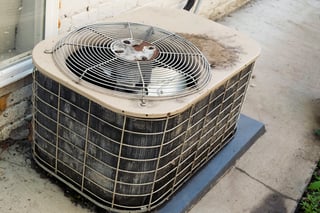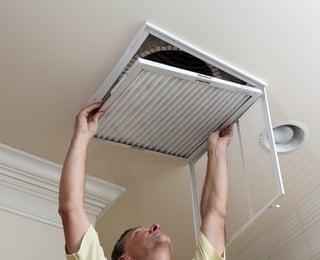 Mold spores are everywhere in the outdoor and indoor environment as a natural part of our world and they cannot be eliminated. Certain conditions are necessary for the growth and proliferation of molds into a problem area within a building. Controlling indoor moisture and humidity levels are key to controlling indoor mold growth. Air conditioning equipment and duct systems are very common locations for the development and amplification of mold in commercial properties. Property owners and managers need to be vigilant in inspecting and maintaining these systems, to minimize the frequency and magnitude of any exposures to occupants from hidden sources of mold.
Mold spores are everywhere in the outdoor and indoor environment as a natural part of our world and they cannot be eliminated. Certain conditions are necessary for the growth and proliferation of molds into a problem area within a building. Controlling indoor moisture and humidity levels are key to controlling indoor mold growth. Air conditioning equipment and duct systems are very common locations for the development and amplification of mold in commercial properties. Property owners and managers need to be vigilant in inspecting and maintaining these systems, to minimize the frequency and magnitude of any exposures to occupants from hidden sources of mold.
Conditions leading to mold growth
Key ingredients necessary for mold growth include adequate moisture, adequate temperature, and a source of organic material from which the mold can extract nutrients for growth. Air conditioning systems provide these key ingredients and therefore are very favorable environments for mold growth.
- Moisture – As part of its normal operation the cooling effect of the air conditioner raises the relative humidity of the circulating air, ultimately leading to moisture condensation from the air as it passes through the AC. The elevated relative humidity of the cooled air and the condensed moisture are the most important source ingredients for air conditioning system mold growth. Indoor humidity in the range of 45% to 55% is ideal for limiting the spread of viruses, bacteria, and the growth of dust mites.
- Temperature – Most molds only grow at temperatures above 40° F, but surface temperatures in the range of 68° F to 86° F are optimum for mold growth, and frequently exist in the AC system, and elsewhere in the home.
- Nutrients – Any organic material is a potential food source, including atmospheric dust, which is continuously deposited in the air conditioning apparatus and ductwork even though air filtration is provided.
When mold growth is active in the air conditioning system (or the garbage can) the occupants frequently smell a musty or moldy odor; these are the gases (abbreviated mVOCs) produced by the active mold growth. Any of the above conditions (moisture, temperature, nutrients) being sufficiently altered can cause the mold to become dormant. When the musty or moldy odor stops being noticeable, it is a sign that the mold is becoming dormant, however the mold is still present and will begin actively growing again when moisture and temperature conditions are favorable. Unless physically removed, the mold may continue to be an irritant.
Air Conditioning System-Specific Mold Problem Areas
The goal of the air conditioning system is to treat the air only to a level which provides acceptable indoor air quality and thermal comfort. It follows then that any uncontrolled air leakage into or out of the building or AC system will reduce the AC system energy efficiency, as the equipment must work harder to keep the indoor environment within acceptable levels. In addition to increased energy consumption, these uncontrolled air flows may also trigger other locations of mold growth. Uncontrolled air leakage pathways are numerous. Some of the more common AC system related pathways contributing to mold incidence include:
- Cold AC supply air duct leakage into the unconditioned attic or crawl space. This cold air can cause localized moisture condensation and a potential mold initiation site upon contacting an attic or crawl space surface;
- An unsealed supply or return air duct penetration from the building into the untreated attic or crawl space provides a source for untreated (humid, dusty, possibly moldy) outdoor air to infiltrate the building. These moist air sources are then exposed to cool indoor air and indoor surfaces leading to elevated local moisture levels which can result in mold growth.
- Poorly fitted filter or AC cabinet access doors or unsealed duct connections at the AC unit. When the AC unit is located within an unconditioned and possibly damp indoor space (eg basement) or when located outdoors, the uncontrolled outdoor air flow leakage will be pulled into the AC system, resulting in increased cooling energy usage, increased air filtration dust loading and increased levels of mold spore recirculation within the building.
- Plugged or improperly installed drainage piping on AC unit cooling coil condensation drain pans. These areas must be inspected and cleaned regularly as they become clogged from the buildup of dirt, biofilm or other debris. These systems must allow the continuous free flow and drainage of water to a location for proper disposal either to outside the building or to an interior building drain. Failure to maintain this piping system and drain pan with regular cleanings will result in condensate back up and spillage into the building, and create an opportunistic mold growth site.
- Poorly insulated or improperly suspended insulated refrigerant lines. Insulation on these lines must be of adequate thickness and continuous, with all joints sealed within the building to avoid cold pipe surfaces which could serve as sites for moisture accumulation and possible mold growth. Hangers used for supporting refrigerant lines and condensation pipes must not compress the pipe insulation excessively as doing so would increase the likelihood of surface moisture condensation and mold growth.
Common AC Ductwork and Equipment Mold Locations
Although able to grow on any surface, primary sites for AC system mold growth include the air conditioning unit condensate drain pan, components like the cooling coil and air circulation blower, the AC cabinet insulation, and ductwork internal insulation liners especially in the immediate vicinity of the AC equipment.
During system operation, the coil drain pan is continuously collecting dirt containing organic material and moisture condensed from the circulating air stream as it passes through the cooling coil. The pan and drain piping are constantly susceptible to fouling from the biofilm produced under these conditions. Failure to clean these areas may lead to drain pan overflow, which in turn can contaminate other surfaces within or nearby the AC unit.
The AC cabinet insulation and internal ductwork (liner) insulation's are also areas of specific concern. Their relatively rough and porous surfaces tend to accumulate dust containing organic material, and may create ideal sites for the initiation of mold growth if they become wet. These areas are susceptible to moisture accumulation from coil moisture blow off (water droplets from the cooling coil carried downstream by the air flow), drain pan overflow, and pipe sweating.
Management of AC Ductwork and Equipment Mold Factors
 What can be done to manage these areas?
What can be done to manage these areas?
Replace your air filter regularly and ensure that it seals well in the filter track to prevent air bypass. Filters with higher dust removal efficiency are available from numerous sources including your AC service center. When upgrading your furnace filter, beware that a higher performance air filter makes your furnace work harder to circulate air through the building. Ensure that installation of the better filter does not reduce furnace air flow to a level that limits adequate cooling of the building. Consult with your service provider if guidance is needed.
The condensate drain pan is usually accessible for cleaning and removal of deposited organic material, and biolfilm. The drain pan piping should also be cleared of any dirt or biofilm buildup that might obstruct the free drainage of water from the pan. Air circulation blowers, cooling coils and other hard non porous surfaces can be cleaned periodically to remove the accumulation of organic material. Thorough cleaning of these areas is likely to require the support of a professional cleaning service.
Cleaning of dirty fiberglass liners or other insulation surfaces may be performed however care must be taken to avoid damaging or loosening the insulation, and might be better handled by a professional cleaning surface. EPA and NADCA recommend wet or mold containing fiberglass linings within equipment and ductwork be removed and replaced, since these materials are not able to be dried or cleaned completely of all mold.


